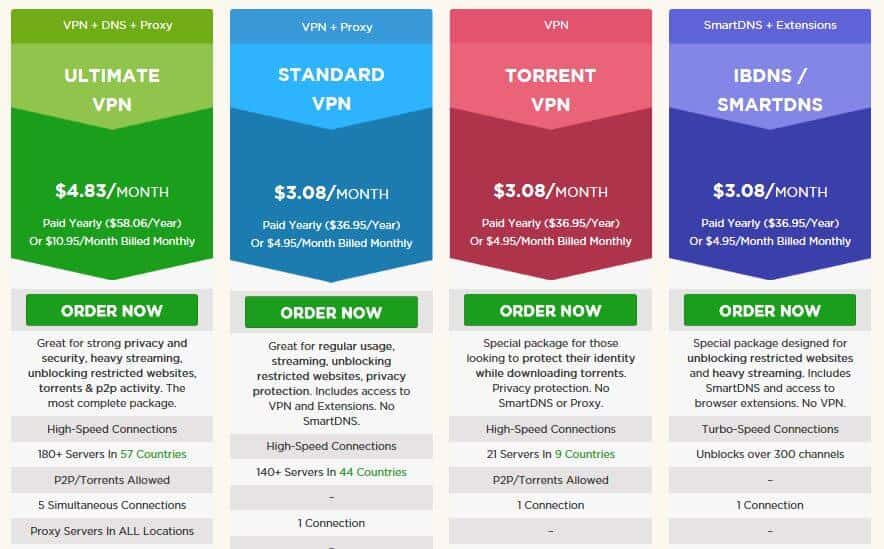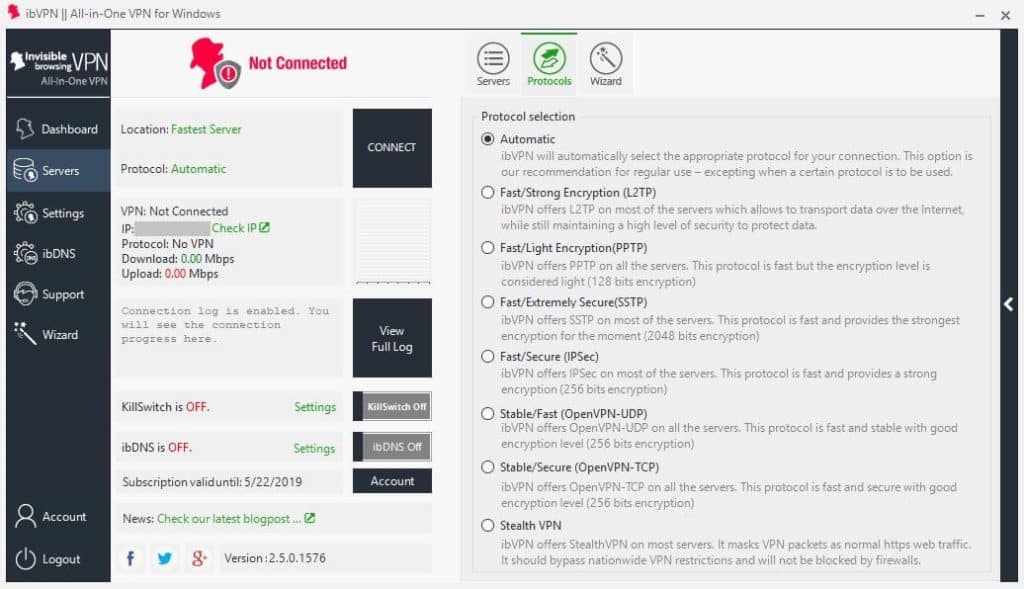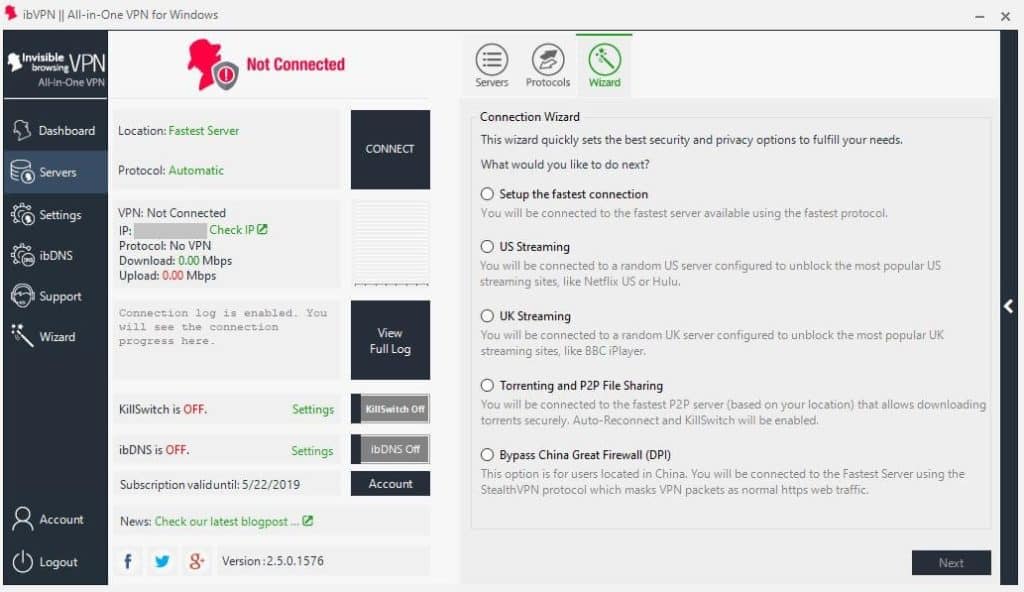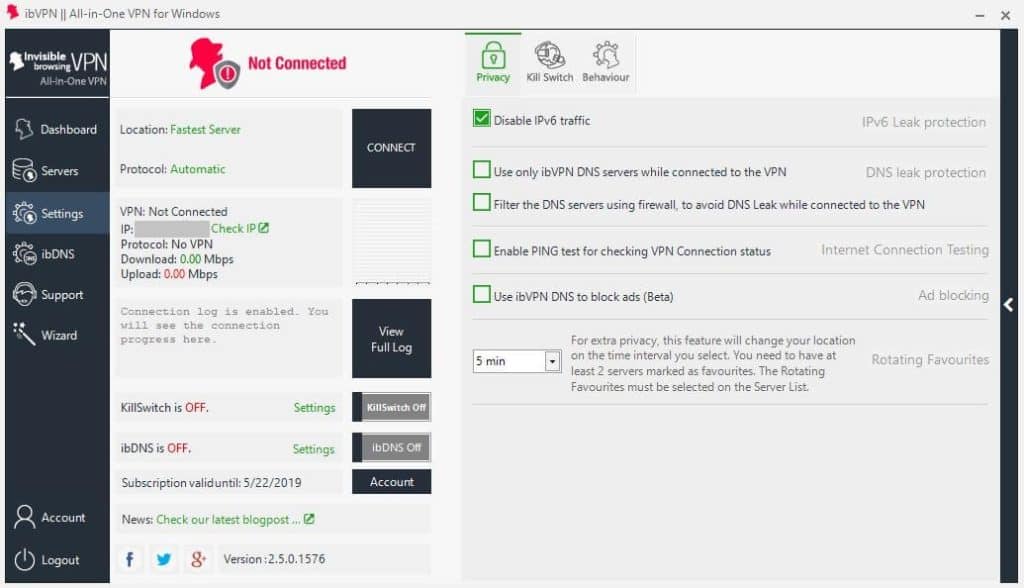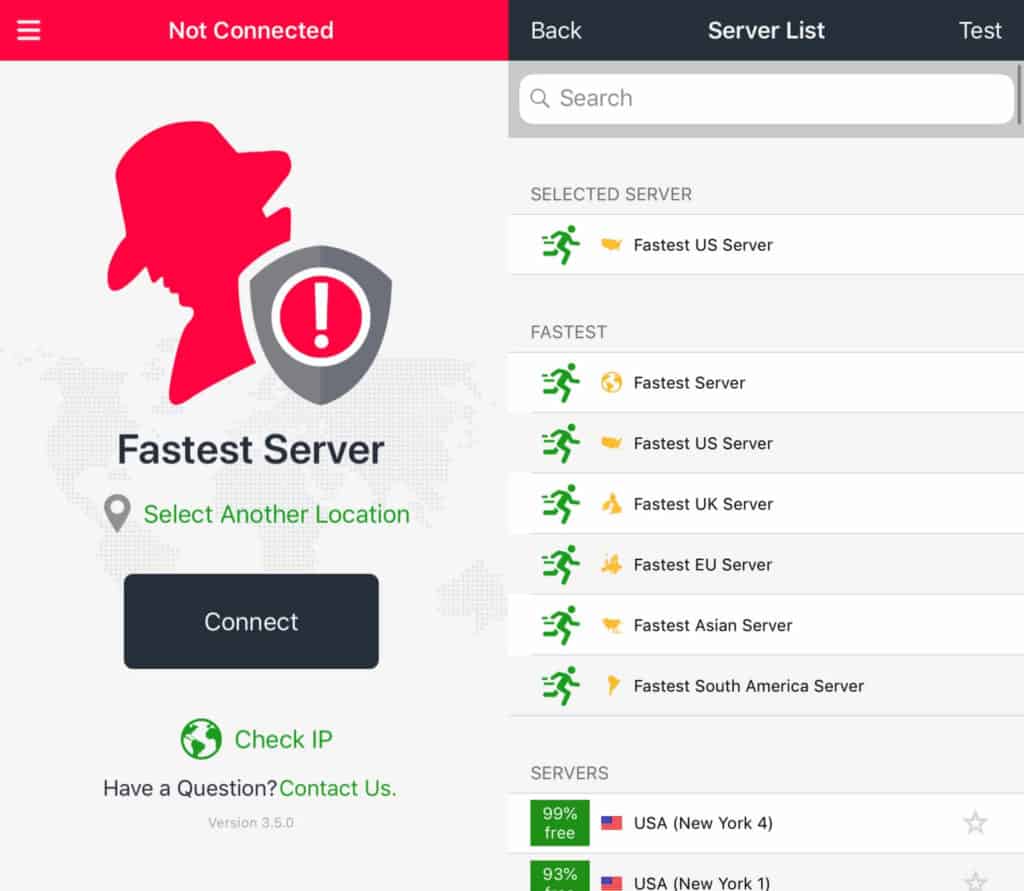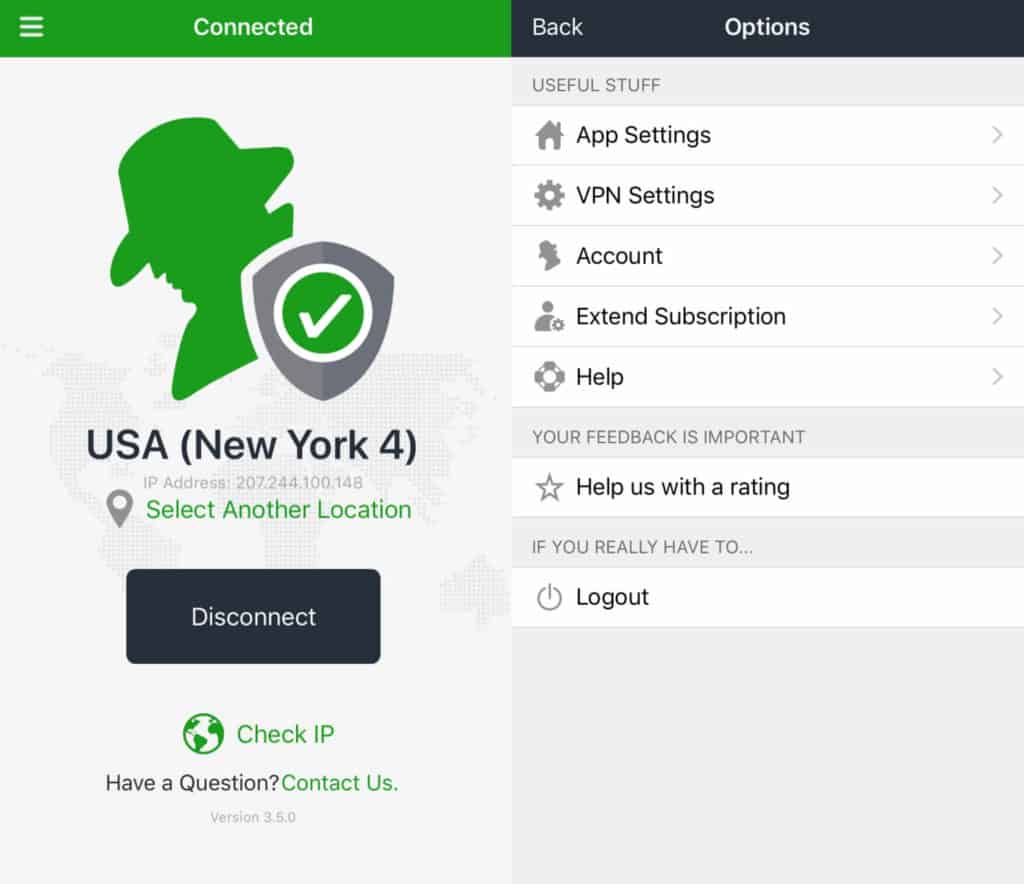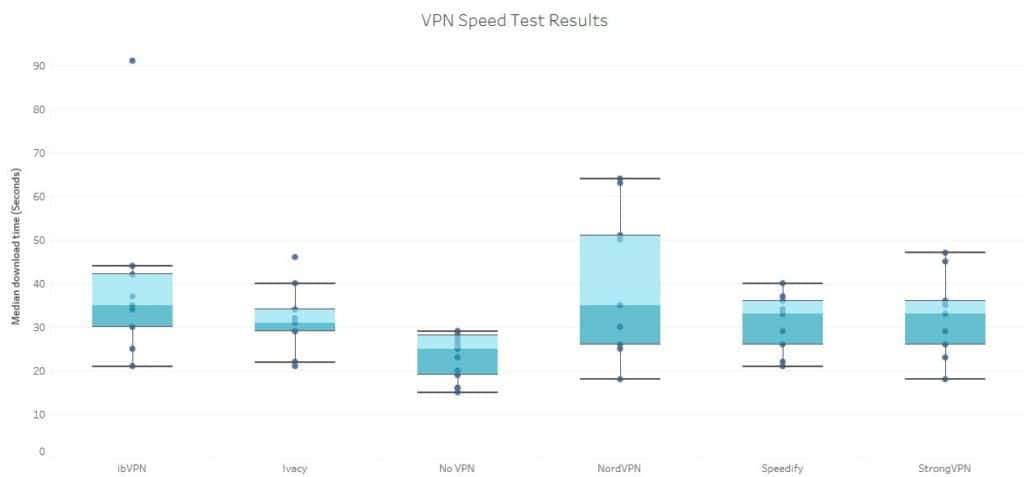ibVPN is a product of Romania-based Amplusnet ARL. The company started with a proxy service in 2003, but launched an encrypted VPN service, ibVPN, in 2010. With a small server network, you might not expect much from this provider. But it promises big performance.
We’ve taken it for a test drive to see how it stacks up against the competition. Our in-depth review will cover price, security, speed, network, customer service, and more.
Features and pricing
ibVPN are offering the following summer deals until the end of September:
- 78% OFF Exclusive 2 years Ultimate VPN plan, fully featured ($58.06 paid every 2 years – only $2.42/month)
- 50% OFF for Standard VPN any subscription plan (starting at 1.47/month paid annually)
One thing’s for certain right off the bat with ibVPN: it’s far from simplistic. The plan options alone are enough to baffle many advanced users let alone beginners. If you know exactly what you want from a provider, then you’ve come to the right place. If you’re a first-time VPN user looking for a one-size-fits-all option, you might be a bit overwhelmed by the ibVPN website.
Below are the four options available with a few of the features included — the lists are twice as long as what is shown here.
Basically, you have a full package (Ultimate VPN) and three lower tier packages. Those three are all the same price as each other but include a hand-selected subset of the ultimate VPN package features, tailored to a specific use. These three only allow for one device to be connected at a time.
The Standard VPN gives you access to most servers but doesn’t allow P2P (read: torrenting) and lacks some of the special Ultimate VPN options, such as Tor over VPN and Double VPN. The Torrent VPN enables access to a select set of servers that allow P2P filesharing. It comes with Socks5 proxies but doesn’t include browser extensions. The third of the low-tier options is IBDNS/SMARTDNS, which isn’t a VPN at all and simply gives you access to the SmartDNS proxy server. All plans come with unlimited data.
The three lower-tier options each cost $36.95 for an annual plan, which works out to $3.08 per month. Opting for a six month plan will cost $19.95, which is about $3.32 per month, so not much more expensive than the annual term. Finally, you’ll spend $4.95 per month if you’re paying on a monthly basis.
The Ultimate VPN plan costs $58.06 ($4.83 per month) for the annual plan. The six month deal isn’t quite so attractive at $42.95, which is $7.16 per month. Finally, a monthly payment plan will cost $10.95 per month. All Ultimate VPN packages allow for up to five simultaneous connections. It offers all of the features we’ve mentioned so far, including P2P. You get access to additional servers (just under 200 in total) and extra features including Tor over VPN, Double VPN and Stealth VPN. We’ll cover these in a bit more detail later.
If you have more than one device, which most people do, then the Ultimate VPN seems like a no-brainer. It gives you five connections instead of one, at just $1.75 more per month on an annual plan.
When comparing ibVPN to other VPN services, we’ll look at the Ultimate VPN package, as this is most similar to what other providers offer. From a pricing standpoint, it’s about middle-of-the-road, but many providers offer longer term plans with steeper discounts. It’s not uncommon to get a great plan for under $3 per month when you sign up for two or three-year terms.
ibVPN apps are available for Windows, MacOS, iOS, and Android. The VPN can be manually configured on Linux and some routers. Payment options include major credit cards, bitcoin, and other cryptocurrencies, SMS (for Romanian users only), Perfect Money, and Paymentwall.
All plans come with 15-day money-back guarantee. This isn’t as generous as some providers, but it’s probably enough time for most people to decide whether or not this is the right service for them. If you’d rather not hand over payment details just yet, ibVPN does offer a 24-hour free trial of its full service. You only need to provide an email address to access this.
All plans include solid security in the form of 256-bit Blowfish encryption with perfect forward secrecy. Apps come with built-in DNS and IPv6 leak protection and a kill switch. You can select between the OpenVPN, PPTP, L2TP, SSTP, and IPSec/IKEv2 protocols. 24/7 live chat support is available with all plans should you have questions or need help with setup or troubleshooting.
Setup and interface
As mentioned, the Ultimate VPN plan seems like the most attractive option. Aside from having access to all available features, you also have five simultaneous connections. If you’re covering a family, or you tend to switch a lot between devices, then you’ll need more than one connection.
Once you’ve decided on and signed up for your plan, setting up the VPN is simple. Just download and install the appropriate app, then launch and sign in.
We took the Ultimate VPN package for a test run on Windows and iOS, although the interface should be similar for all plans.
Desktop
After downloading and installing the client, you can launch and enter your credentials. A word of warning: it’s easy to be overwhelmed by what greets you. This is partially due to the fact that the app launches to what is essentially two screens in one. On the left is the main dashboard, which will be visible for any tab you choose. The right side is the Servers tab that automatically opens when you launch the app. If you click Dashboard to the left of the screen, the client will be reduced to just the left portion.
Within the dashboard itself is the connection, server location, current IP address, protocol, and download and upload speeds. You also see your connection logs if enabled, the kill switch and ibDNS status, and subscription information.
Over in the Servers expansion, you have three subtabs: Servers, Protocols, and Wizard. Servers gives you a list of servers, which you can list A-Z by country (the city is also shown) or group by favorites, continent, Tor over VPN, Double VPN, torrent, or gaming. You can also choose the fastest server or fastest favorite, rotate favorites, or select the fastest P2P server.
The Protocols tab gives you all of your protocol options including detailed explanations for each one.
Finally, the Wizard tab gives you options to help you connect to a server suitable for specific needs such as US or UK streaming or bypassing China’s Great Firewall.
Below the Servers tab on the left of the dashboard, you’ll find Settings. Here you have another three subtabs: Privacy, Kill Switch, and Behaviour. The Privacy tab enables you to adjust settings for IPv6 and DNS leak protection, ping tests, ad-blocking, and rotating favorite servers.
In the Kill Switch section, you can turn off the Internet KillSwitch, a blanket switch that kills the internet connection to the entire device if the VPN connection is lost. Alternatively, you can opt for the Application KillSwitch that enables you to select which applications will be covered by the kill switch and which will not. Note that the regular kill switch is enabled by default.
The Behaviour tab houses settings for the behavior of the app, such as startup and notification selections.
The final dashboard tab of note is the ibDNS section. Here, you can select a server to use with the SmartDNS feature. This will reroute DNS requests and enable you to unblock geo-restricted content, likely with faster speeds than you’d get with the VPN. However, note that by using this feature, the VPN will be turned off and your traffic will no longer be encrypted.
Clearly, this client offers a lot of options. On the plus side, it has plenty of room to tailor your VPN experience. And while the choices might be overwhelming for beginners, everything is fairly well-explained within the app, so there’s minimal need to consult support documentation. Overall, the aesthetics are very basic and in stark contrast to many of the sleek modern clients offered by competitors. But if you don’t mind function over form, then it works.
Mobile
The iOS app offers a far different experience to the desktop client and has a more refined look. When you launch and log into the app, you’ll be greeted with a few starter screens with some pointers for use. Then you’ll see the main screen which tells you whether you’re connected and your server choice. Clicking Select Another Location will bring you to the Server List.
This is similar to the one in the desktop client, but with fewer options, and enables you to choose a server based on location. You can also opt to go for the fastest server within a select region, such as the US, the UK, or South America.
Once you’re connected, the main screen will change to a green background and your new IP address will be displayed.
To access settings, click the menu icon in the upper left-hand corner of the screen. The main tabs of interest within the Options screen are App Settings and VPN Settings.
The App Settings tab houses a few simple options for the app behavior. The VPN Settings has a few miscellaneous choices including opting to auto-activate the VPN when the device connects to the internet and switching protocols.
There are far fewer options in the mobile app than in the desktop client. While this makes it a little more user-friendly, advanced users might miss the additional options.
Servers and performance
The ibVPN server network is very small with just under 200 servers currently in action. It does cover 57 countries, which isn’t too shabby. To put it in perspective, you have competitors like NordVPN with thousands of servers and ExpressVPN covering 94 countries. Although, we’ve been impressed by small providers before, such as PrivateVPN, which has a network of fewer than 100 servers.
When deciding which server to connect to, as covered earlier, you have a number of options. If you choose the fastest server or one of the fastest x server options (where x is a region or function), the app tests all relevant servers to give you the fastest one. Even when testing all servers, this only took around 30 seconds, which means it is likely testing latency rather than download speeds. Unsurprisingly, we were typically connected to a geographically close server.
While using this VPN, we tested various servers and had a great experience overall. There was no noticeable lag while browsing and we were able to stream 1080p and play online games with no issues. Connecting to a new server was usually fairly quick and painless. There was some noticeable slowdown when trying to access content through geographically distant servers, so that could be frustrating for some users.
ibVPN speed test performance
When we run our speed tests, we aim to be as empirical as possible. The tests are run from Toronto and are comparable to tests run for other VPN providers. We download a 100MB file from a server in Oregon using three VPN test servers in the US East, US West, and UK. We test against a control (with no VPN) and repeat at three different times during the day.
The results are displayed in the boxplots below. For each provider, the line where the light and dark blue boxes meet shows the median speed. Lower is faster. The spread in results is indicated by the overall size of the box. Smaller means more consistent.
As you can see from the plot, ibVPN did okay on these tests. Speeds using the US servers were around 20-30% slower than the control, which isn’t bad at all. Things did get quite a bit slower when we connected to the UK server, with one result being more than three times slower than the control. It’s normal to see slowdowns for geographically distant servers, but this represents a noticeable impact which could be off-putting for some users.
It’s worth noting that these tests can only serve as a general indicator of what you might see. The inherent volatility of the internet adds a significant factor of randomness, so these tests should be taken with a grain of salt. They were run while using a 60Mbps connection, so you could see longer wait times with a slower connection, and maybe smaller or larger discrepancies.
Does ibVPN unblock Netflix?
Yes, ibVPN does unblock Netflix. With Netflix cracking down on the use of VPNs to access its services, it’s becoming more and more difficult to circumvent the dreaded Netflix proxy error. Thankfully, ibVPN seems to be up to the task. US Netflix worked seamlessly for every US server we tested, both in the desktop client and the VPN app.
It does appear that this only applies to the US Netflix library. When we connected to other servers and tried their corresponding libraries, we didn’t have any luck. With the US library being the biggest and most popular, it seems many VPN providers prioritize providing access to US Netflix.
Of course, you may want to access streaming services other than Netflix. We tested a few more, including Amazon Prime Video and BBC iPlayer. ibVPN unblocked them with no issues.
Does ibVPN work in China?
Yes, ibVPN does work in China. In fact, this provider has set up dedicated double VPN servers for users in China. Using the Double VPN China2US option, you can connect to a US server. And if you want a European server, you can opt for Double VPN China2EU which will connect you to a Netherlands server.
While you don’t have a great selection of servers, it should be enough to bypass China’s Great Firewall and enable access to blocked content including sites like Facebook, Google, and Netflix.
Many providers have all but given up on users in China, and few can provide reliable connections. It’s great to see a provider make a concerted effort to ensure users everywhere can take advantage of their services.
Security and privacy
ibVPN is based in Romania where there are no mandatory data retention laws. This means that no personal data can be collected unless the user gives their full permission. Indeed, ibVPN states that it “does not collect or log any traffic or use of its Virtual Private Network service. We cannot relate any specific activity with any specific user.”
ibVPN uses Blowfish encryption with 256-bit keys. This is weaker than 256-bit AES encryption — a popular choice among competitors — although Blowfish is still considered very strong. This is in conjunction with 2,048-bit RSA keys for authentication and DHE keys for perfect forward secrecy. You have several protocol options including OpenVPN, PPTP, L2TP, SSTP, IPSec/IKEv2.
Apps come with built-in DNS and IPv6 leak protection. ibVPN uses its own DNS servers, which are more private than public or ISP-run DNS servers. Some providers utilize public DNS servers such as those provided by Google. Even though Google can’t see your IP address, it can track browsing history through DNS requests.
The ibVPN app comes with a built-in kill switch that kills the internet connection should the VPN connection be lost for some reason. This prevents any of your information from leaking outside of the encrypted tunnel. The kill switch is complemented by the auto-reconnect feature that restarts the VPN connection automatically after an unwanted disconnect has occurred.
The ibVPN Ultimate VPN package allows users to use Tor over VPN. This means your connection goes through the VPN server then through the Tor network, without you having to use the Tor browser. This provides access to Tor and the darknet on any browser.
You also have a double VPN option that routes traffic through two servers instead of one. This enhances privacy and security, and according to ibVPN, can actually improve speeds in some cases.
A recent addition to the service is StealthVPN. This masks VPN packets as HTTPS web traffic and should be able to bypass any firewall. This is a light form of obfuscation that works on most servers and can be configured in the Servers > Protocol tab.
Customer service
ibVPN is dedicated to providing excellent customer support. In the Help tab on the website, you’ll find setup guides, an FAQ section, and a knowledge base housing hundreds of articles.
The support forum is where you can discuss issues or other topics with members of the ibVPN community. If you’d rather speak to an ibVPN representative, you have several contact options. You can submit a ticket, send an email, or opt for live chat support. The lattermost is prompt and knowledgeable but it is outsourced to Zendesk, so more privacy-conscious users may want to stick with submitting a ticket.
Finally, if you need remote support, there’s a dedicated option for that. You can select the Remote Assistance option on the help page and schedule an appointment for whenever is convenient for you. This can be either screen sharing or remote access, whatever you’re most comfortable with.
Verdict
ibVPN offers a solid all-round option for most users. It has decent speeds and can unblock various streaming sites, so if you’re primarily looking to unblock geo-restricted content, it could be a good fit. Plans come with unlimited bandwidth and many servers are suitable for P2P, so torrenters will be happy, too.
Beginners might be a bit put off by the complex pricing plans and complicated desktop clients. More advanced users will be happy with the flexibility. The small number of servers might present an issue, and indeed could be a reason for the few slow speed test results we saw.



